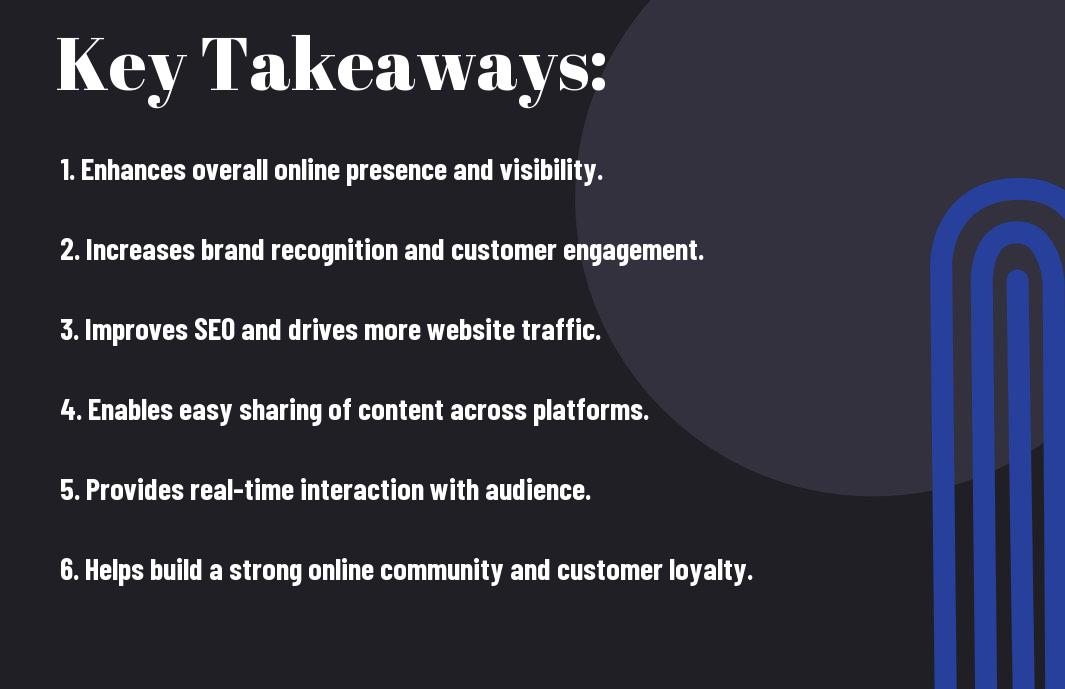The Importance Of Social Media Integration In Modern Website Design

10 Steps To Creating A Custom Website Design For Your Small Business
March 29, 2024
Integrate Social Media Marketing Seamlessly Into Your Website
April 2, 2024Over the past decade, social media has revolutionized the way we connect, share information, and engage with one another online. In website design, integrating social media platforms has become not just a trend but a key strategic necessity for success. With billions of active users on social media platforms daily, the potential for expanding a website’s reach, driving traffic, and increasing engagement is immense. This blog post investigates into the critical importance of incorporating social media elements seamlessly into modern website design to enhance user experience, boost visibility, and ultimately achieve business goals.
Key Takeaways:
- Social Media Presence: Integrating social media into website design is crucial as it helps boost your online presence and reach a wider audience.
- Enhanced Engagement: Social media integration allows for increased engagement with users, as they can easily share content, comment, and interact with your brand.
- Improved Brand Visibility: Including social media buttons on your website improves brand visibility and credibility, as users can connect with your brand across various platforms.


Understanding Social Media Integration
Definition and Scope
Some websites today are not just standalone entities; they are interconnected hubs that harness the power of social media integration. This integration refers to the inclusion of social media platforms within the website framework, allowing seamless interaction between the two.
Benefits of Social Media Integration in Websites
To fully comprehend the significance of social media integration, one must recognize the multitude of benefits it brings. Integrating social media into websites can significantly boost brand exposure, enhance user engagement, drive website traffic, and improve overall search engine rankings.
Social media integration also enables businesses to leverage user-generated content and facilitate sharing, liking, and commenting directly from the website. This not only fosters a sense of community but also amplifies social proof, building credibility and trust among potential customers.
Strategies for Effective Social Media Integration
Choosing the Right Platforms
Platforms are crucial when it comes to social media integration on a website. Choosing the right platforms to showcase your brand and connect with your audience is necessary. It’s important to focus on platforms that align with your target demographic and business goals. Whether it’s Facebook, Instagram, Twitter, LinkedIn, or Pinterest, each platform serves a different purpose and caters to a specific audience. By understanding where your audience spends their time, you can tailor your social media integration efforts for maximum impact.
Design Techniques for Seamless Integration
Integration is key when incorporating social media into your website design. Design techniques for seamless integration include strategically placing social media icons, incorporating social feeds, and ensuring consistency in branding across all platforms. By seamlessly integrating social media elements into your website design, you create a cohesive and engaging user experience. Make sure that social media buttons are easily accessible and prominently displayed to encourage visitors to connect with your brand on various platforms.
Challenges and Best Practices
Privacy and Security Considerations
To address the challenges related to privacy and security when integrating social media into website design, it is crucial for businesses to prioritize the protection of user data. Implementing secure login processes, encrypted connections, and regular security audits can help mitigate potential risks. It is also imperative to comply with data protection regulations such as GDPR to ensure the privacy rights of users are respected.
Maintaining Brand Consistency Across Platforms
To ensure maintaining brand consistency across various social media platforms, businesses should establish clear brand guidelines that encompass visual elements, tone of voice, and messaging. Consistency in brand imagery, colors, and communication style helps reinforce brand identity and fosters brand recognition among followers. Utilizing social media management tools can streamline content creation and scheduling, allowing for a cohesive brand presence.
Across all platforms, maintaining consistent branding elements such as logos, color schemes, and brand messaging is imperative for brand recognition and credibility. Inconsistencies can confuse users and dilute brand identity, impacting overall brand perception and trust. By aligning branding efforts across social media channels, businesses can strengthen their brand presence and establish a unified brand image in the digital landscape.

Impact and Future Trends
Analyzing the Effectiveness of Integration
One of the most crucial aspects of modern website design is the integration of social media platforms. Studies have shown that websites with seamless social media integration experience higher engagement rates, increased traffic, and improved brand visibility. By analyzing the effectiveness of integration, businesses can better understand the impact of social media on their online presence.
Predictions for Social Media and Web Design Synergy
Effectiveness is key when predicting the future trends of social media integration in website design. As technology continues to advance, we can expect to see even greater synergy between social media and web design. Design elements that encourage social sharing, user-generated content, and real-time interaction will become central to a successful online presence.
Design strategies that prioritize seamless integration with social media platforms will be imperative for businesses looking to stay ahead in the digital landscape. By creating a unified online experience that incorporates the latest social media trends, brands can connect with their audience on a deeper level and stay relevant in an ever-evolving online marketplace.

Summing up
With these considerations in mind, it is clear that social media integration plays a crucial role in modern website design. By seamlessly incorporating social media elements into your website, you can boost engagement, increase brand visibility, and create a more dynamic online presence. To learn more about the importance of integrating social media into your website design, check out Integrating Social Media into Your Website Design – POWR Blog.
FAQ
Q: Why is social media integration important in modern website design?
A: Social media integration in modern website design is crucial as it allows businesses to connect with their audience, increase brand awareness, drive traffic to their website, and improve search engine rankings.
Q: How can social media integration benefit a website?
A: Integrating social media into a website can help increase user engagement, foster brand loyalty, provide social proof, and generate leads for the business.
Q: What are some effective ways to integrate social media into a website?
A: Some effective ways to integrate social media into a website include adding social sharing buttons, displaying live social media feeds, creating social login options, and using social media plugins.
How does social media integration impact user experience?
A: Social media integration can enhance user experience by allowing visitors to easily share content, engage with the brand on various platforms, and stay connected with the latest updates and promotions.
Q: What are the best practices for social media integration in website design?
A: Best practices for social media integration in website design include choosing the right social platforms for the target audience, ensuring consistent branding across all social channels, regularly updating social content, and monitoring social media analytics to track performance.


